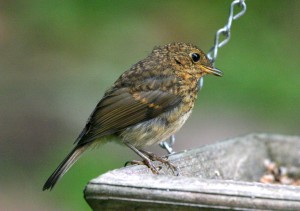 The robin is one of Britain’s best loved birds especially in gardens where it can become very tame and will even come to hand for food. This year has been an outstanding one for the number of young birds around from blackbirds to blue tits and chaffinches to siskins. However, perhaps the most successful bird this year has been the robin and there is evidence in my garden that they brought off not only two broods but even three with some pairs. The photograph I took last week in the garden is an example, as this is a very young juvenile, with very yellow gape to its beak so has not been out of the nest very long. Considering it is now the end of September, this means this could well have been evidence of three broods from one pair of adults.
The robin is one of Britain’s best loved birds especially in gardens where it can become very tame and will even come to hand for food. This year has been an outstanding one for the number of young birds around from blackbirds to blue tits and chaffinches to siskins. However, perhaps the most successful bird this year has been the robin and there is evidence in my garden that they brought off not only two broods but even three with some pairs. The photograph I took last week in the garden is an example, as this is a very young juvenile, with very yellow gape to its beak so has not been out of the nest very long. Considering it is now the end of September, this means this could well have been evidence of three broods from one pair of adults.
Part of the robins success is down to the very Catholic taste of the adults in their choice of nesting sites. It is only the female that builds the nest and it could be in ivy on a wall, amongst roots or undergrowth on banks, inside a shed, inside any stationary machinery or an open fronted nestbox. They also have the bizarre reputation of building a nest in such places as old saucepans, old kettles and the like, but they all seem to work. Breeding is comparatively early and may take place in late March and there are five or six eggs in the clutch. These are incubated by the female, she seems to do everything, for 12-15 days and then the chicks will fledge after around two weeks. If there is a second brood that follows quickly then the male robin finds its role at last as it will feed the first brood whilst the female is laying and incubating the second clutch of eggs.
So what do we really know about the robin that delights many gardeners by foraging at their feet whilst the soil is being turned over? There is no shortage of references to robins in literature, although sometimes it is difficult to sort out the myths and fiction from the actual fact. The most famous book on the robin was written by David Lack and published in 1943 “The Life of the Robin”. How apt that there is now an up to-date version and the one I always refer to by his son Andrew Lack who wrote “Redbreast – The Robin in Life and Literature” published in 2008. In there is the longest version of the most famous poem on robins with no less than 14 verses. It starts with the never forgotten lines “Who killed Cock Robin? / I said the Sparrow, / With my bow and arrow, / And I killed Cock Robin”. Ironically the robin is such a pugnacious bird that it is quite unlikely a sparrow could ever kill one, but that is all part of the myths surrounding the robin. After a poll in the Times in 1960, the robin was elected as Britain’s national bird, although these days there seems to be some confusion which bird now holds this accolade.
The robin is always associated with Christmas and occurs on stamps and cards and other stationary but as such the bird originally had nothing to do with the festive season. What happened was that the first postmen had a uniform that included a bright vermillion waistcoat. They soon became known as “robins” and this is the reason robins are now often shown on Christmas cards and even shown with a letter in their beak actually delivering the mail!
Tags: highland wildlife
